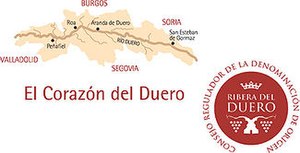Ribera del Duero
41°41′N 3°41′W / 41.683°N 3.683°W
Denominación de Origen Protegida (DOP) | |
| Year established | 1982 |
|---|---|
| Country | Spain |
| Size of planted vineyards | 22,395 hectares (55,339 acres) |
| Wine produced | 915,978 hectolitres |
| Comments | Data for 2016 / 2017 |
Ribera del Duero is a Spanish
The region is characterised by a largely flat, rocky terrain and is centred on the town of
Ribera del Duero was named Wine Region of the Year 2012 by
History
Wine has been produced in the region for thousands of years, but

The denominación de origen (D.O.) of Ribera del Duero was founded on 21 July 1982 by an organization of wine producers and growers who were determined to promote the quality of their wines and enforce regulatory standards.
Ribero del Duero wines are currently enjoying greater popularity, thanks largely to the considerable interest shown in the area by experienced growers from other regions.
Geography

The Ribera del Duero is located on the extensive, elevated northern plateau of the Iberian Peninsula. It occupies the southern plains of the
Geologically, tertiary sediments, consisting of gently lenticular layers of silty or clayey sand, alternate with layers of limestone, marl and chalky concretions. The Duero valley, formed during the Miocene period, has a flat, rocky, gently undulating terrain, ranging from 911 metres (2,989 ft) down to 750 metres (2,460 ft) above sea level.[8] The national highway N122 follows the river valley.
The Ribera del Duero has moderate to low rainfall (450 millimetres (18 in) per year) and is exposed to quite extreme climatic conditions; long, dry summers with temperatures of up to 40 °C (104 °F) are followed by hard winters during which temperatures often come close to freezing temperatures.
Vineyards occupy around 120 square kilometres (46 sq mi) of the region, most of which are situated in the province of Burgos, with around 5 square kilometres (1.9 sq mi) in Valladolid and 6 square kilometres (2.3 sq mi) in Soria.[11]
Grapes
Wines produced in the Ribera del Duero DO derive almost exclusively from red grapes. The vast majority of production is dedicated to
The DOP's authorized red grapes are: Tinto Fino, Cabernet Sauvignon, Merlot, Malbec, and Garnacha Tinta. The Albillo grape is the only authorized white variety grown, for white wines that are mostly destined for local consumption.
Main Wineries
There are more than 300 wineries that belong to the D.O., some of them are:[12]
- Bodegas Casajús, Páramo de Corcos, Pago de los Capellanes, Bodegas TresPiedras, Dominio Basconcillos, Adrada Ecológica, Casado Alvides, Viña Sastre, Frutos Aragón, Ortega Fournier, Balbás, Linaje Garsea, García Figuero, Izquierdo, Félix Callejo, Cillar de Silos, Ismael Arroyo, Real Sitio Ventosilla, Martín Berdugo, Peñalba, Neo, Valduero, Imperiales, Pascual, Señorío de Nava, Pérez Pascuas, Virgen de la Asunción, Monte Aixa, Montegaredo, Pomar Viñedos, Torres de Anguix, Áster, López Cristóbal, Condado de Haza, Viña Solorca, Páramo de Guzmán, Andrés Matey, Gallego Zapatero, Viyuela, Valle de Monzón, Los Matucos, Prado de Olmedo, Muntra, Portia, San Mamés, Valderiz, S.A.T. San Pablo, Asenjo & Manso, Grandes Bodegas, Fuentenarro, Pagos del Rey, Viña Arnáiz, Santa Eulalia.
- Abadia Retuerta, Pago de Carraovejas, Bodegas Protos, Sarmentero, Selección de Torres, Dehesa de los Canónigos, Comenge, Legaris, Dominio de Pingus, Postigo Vergel, Montebaco, Señorío de Bocos, Zifar, Tinto Pesquera, Yllera, Hacienda Monasterio, Viñedos del Jaro, Alión, Matarromera, Emilio Moro, Emina, Montecastro, Arzuaga Navarro, Valtravieso, Tamaral, Castillo de Peñafiel, Peñafalcón, Resalte, Pingón, Viña Mayor.
- Soria: Valdeviñas.
- Segovia: Aldekoa.
Production

There are other similarities between Rioja and Ribera del Duero. Whereas the wines are quite distinctive as a result of significant differences in
The town of
See also
- Spanish wine
- Cuisine of the province of Valladolid
References
Notes
- ^ Local growers consider Tinto Fino to be a genetic mutation of Rioja's Tempranillo, although there is no hard evidence for this at present.
References
- Cigales (DO), Valles de Benavente (VCPRD) and Valtiendas (VCPRD) regions, as well as Ribera del Duero
- ^ "Wine Region of the year 2012. Wine Region of the year 2012". winemag.com. Archived from the original on 2012-11-30. Retrieved 2012-11-15.
- ^ "Vintage Spain Wine tours. Destinations and wine regions". Vintagespain.com. Archived from the original on 2011-11-20. Retrieved 2011-10-29.
- ^ "History of Ribera del Duero". drinkriberawine.com. Archived from the original on 2010-09-04.
- ^ DrinkRiberaWine.com: History Archived 2009-11-22 at the Wayback Machine, accessed on October 7, 2009
- ^ Decanter.com March 29, 2007: Ribera del Duero awaits appellation upgrade
- ^ Antonello Biancalana - ProMIND software development - DiWineTaste. "Ribera del Duero". DiWineTaste. Retrieved 2011-10-29.
- ^ "Ribera del Duero". Riberadelduero.es. Archived from the original on 2011-09-28. Retrieved 2011-10-29.
- ^ institutt, NRK og Meteorologisk. "Weather statistics for Villanubla". yr.no. Retrieved 2017-07-05.[permanent dead link]
- ^ Peter J. Watzka, Ritz Carlton. "Ribera Del Duero - Spanish Wine Region - Wine Tours Spain". Cellartours.com. Retrieved 2011-10-29.
- ^ [1] Archived September 9, 2006, at the Wayback Machine
- ^ "Bodegas". riberadelduero.es. Archived from the original on 2015-05-18. Retrieved 2020-03-31.


